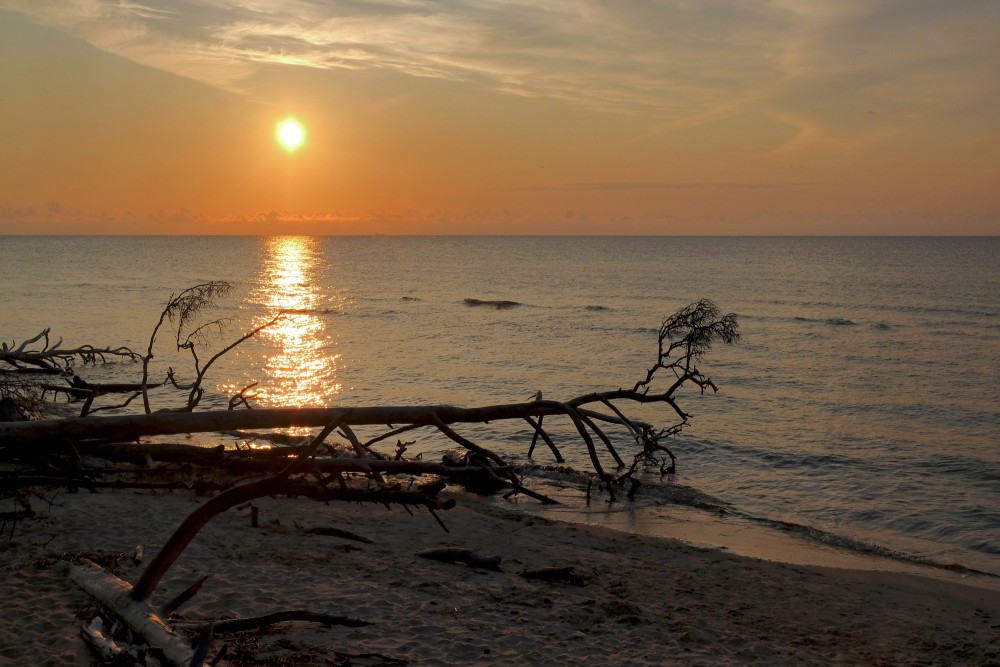Cape Kolka meeting is a stunning location where two powerful waters dramatically converge. The wild Baltic Sea crashes from the northwest, while the Gulf of Riga offers a gentler embrace. This meeting point creates a visible and dynamic line where the two seas blend, constantly shifting with the weather and tides. Travelers come here not only to see this natural phenomenon, but also to experience the stillness, the legends, and the raw beauty of Latvia’s coastline. Moreover, Cape Kolka is not only a geographical highlight, but also a cultural and historical destination that invites reflection and wonder.
Where the Seas Meet: A Rare Natural Wonder
At the Cape Kolka meeting point, visitors stand where two seas visibly merge in a display of nature’s power. On stormy days, the waves from each sea move toward each other with force, creating chaos and foam. On calm mornings, the line between them appears like a silent agreement between powerful giants, gentle yet unmistakable. The contrast in temperature, movement, and color between the two seas is both fascinating and beautiful. Birdsong from the nearby forest often echoes across the shore, blending with the waves to complete this unique and unforgettable experience.
What You Might See Here:
-
Contrasting water movement from both directions
-
Foam lines separating the seas
-
Bird migrations across the shoreline
-
Swirling wind and fog patterns
-
Fishermen and photographers waiting for perfect moments
Cape Kolka Travel Tips and Best Times to Visit
If you’re planning to visit Cape Kolka, timing and preparation can make a big difference in your experience. Spring and late summer are ideal, offering mild weather with fewer tourists compared to the busy July and August season. Because winds can change quickly, it’s important to wear wind-resistant clothing even on sunny days. For safety, avoid swimming directly where the seas meet, as the currents are deceptively strong and unpredictable. Renting a car is recommended for exploring nearby villages, trails, and secluded coastal areas at your own pace.
Travel Tips for Cape Kolka:
-
Visit in May, June, or September for fewer crowds
-
Rent a car for flexibility
-
Avoid swimming at the exact sea meeting point
-
Pack for wind and changing weather
-
Bring binoculars for birdwatching
Fascinating Facts About Cape Kolka
Cape Kolka meeting has both scientific importance and cultural depth, making it more than just a scenic spot. In ancient times, this area was considered sacred by early Baltic tribes who believed sea spirits guarded the cape. Even today, locals speak of myths passed down through generations that involve mysterious happenings and supernatural protection. The surrounding forest contains unique plant species, and the nearby waters hold shifting sandbanks that have challenged sailors for centuries. During the Soviet era, the area was restricted, and only in recent decades has it reopened for tourism and study.
Interesting Cape Kolka Facts:
-
Former sacred site in pre-Christian Latvia
-
Site of many shipwrecks due to shifting sandbanks
-
Nearby forest is a biodiversity hotspot
-
Was once off-limits during the Soviet era
-
Still features local legends of sea guardians
Places to Visit Near Cape Kolka
Cape Kolka is more than just the meeting point — the surrounding area offers stunning experiences. From cultural villages to forest trails and pristine beaches, there is much to explore. Each nearby stop provides a different perspective on Latvia’s natural and cultural richness. Travelers can easily spend a few days exploring these hidden gems, enjoying a slower pace and deeper connection with the land. Whether you’re interested in history, wildlife, or remote solitude, there is something nearby for every traveler.
Slītere National Park
Just a short drive away, this protected area features thick forests, wild animals, and boardwalk trails through ancient landscapes. It is one of the oldest nature reserves in Latvia, offering a diverse ecosystem with both coastal and inland environments. Visitors can climb the Slītere Lighthouse for expansive views that stretch across the sea and forest. With minimal infrastructure, the park maintains a raw, untouched feel that attracts hikers and birdwatchers alike. Nature here is king, and every trail feels like a path back in time.
Highlights:
-
Dense pine and spruce forests
-
Historic Slītere Lighthouse
-
Rare birds and butterflies
-
Well-maintained hiking trails
Mazirbe
This traditional Livonian village retains cultural heritage from the ancient Liv people, one of the smallest ethnic groups in Europe. The Livonian Community House often hosts events and exhibits that showcase the language, songs, and customs of this resilient culture. Small wooden homes and quiet lanes give the village a timeless, peaceful character. Visitors can also walk to the beach, where fishermen still work and the sea breeze carries stories from the past. It’s a meaningful stop for those curious about the human history behind the landscape.
Things to Do:
-
Visit the Livonian Cultural Center
-
Walk to the beach for sunset
-
See old wooden houses and churches
Kolkasrags Beach
Located beside the cape, this beach offers dunes, driftwood, and long walks with the Baltic Sea at your side. It remains mostly undeveloped, preserving its natural charm and quiet atmosphere. The water here is often cold, but the wide beach is perfect for photography, especially at sunrise or sunset. During spring and autumn, you may also catch migratory birds resting on the shore. With its peaceful setting, this beach complements the dramatic energy of the nearby sea meeting point.
Why Visit:
-
Ideal for coastal photography
-
Peaceful, undisturbed setting
-
Great place to watch sea bird migrations
Pitrags and Sīkrags
Other Livonian villages like Pitrags and Sīkrags maintain ancient traditions and offer untouched coastal paths. These small communities are deeply tied to the sea, and you’ll still see boats pulled up beside wooden houses. The roads are quiet, lined with forest on one side and sea on the other. These places offer moments of deep stillness, ideal for long walks, journaling, or simply listening to the sounds of nature. If you’re seeking silence and authenticity, these villages are ideal stops.
Nearby Sights Summary:
-
Slītere National Park: Nature and towers
-
Mazirbe: Livonian culture
-
Kolkasrags Beach: Long, wild walks
-
Pitrags & Sīkrags: Silence and history
Local Cuisine and Where to Eat
While Cape Kolka itself is remote, nearby villages offer delicious Latvian and coastal dishes made from local ingredients. Smoked fish is a must-try, often served with rye bread and pickled vegetables. Cafes and guesthouses also serve hearty soups and traditional Latvian desserts using berries and honey from the area. In summer, pop-up food stalls appear, selling jam, dried herbs, and wild mushrooms. Most places are family-run, offering a personal and welcoming dining experience that adds depth to your trip.
Tasty Local Foods to Try:
-
Smoked Baltic herring
-
Fresh rye bread
-
Cold beetroot soup (aukstā zupa)
-
Local honey and wild berry jam
-
Herbal teas from forest plants
Spiritual and Wellness Experiences
Cape Kolka also attracts visitors seeking quiet, introspection, and personal renewal. The natural setting—windswept dunes, shifting tides, and ancient forests—offers a calming backdrop for reflection. Some guides offer meditation walks or yoga sessions near the shore or within the forest. Even without formal sessions, many visitors find the environment healing. Disconnecting from devices, listening to the sea, and walking barefoot on the sand bring clarity and peace. This area offers space for those needing to slow down and reconnect with themselves.
Mindful Activities:
-
Forest bathing
-
Meditation walks
-
Beach yoga
-
Digital detox getaways
-
Writing or journaling retreats
The Cape Kolka meeting of the Baltic Sea and Gulf of Riga creates an unforgettable travel experience for all kinds of explorers. It offers more than scenic beauty — it represents nature’s complexity and the quiet strength of Latvia’s coastline. From hiking in Slītere’s forest to walking through Livonian villages, every path leads to something meaningful. The cape itself stands as a powerful symbol of balance, where opposites meet and coexist in harmony. Whether you come for photography, history, or peace of mind, Cape Kolka stays with you long after you leave.

